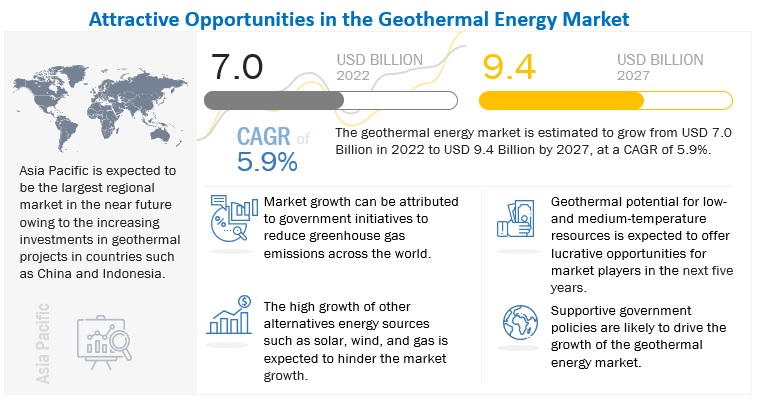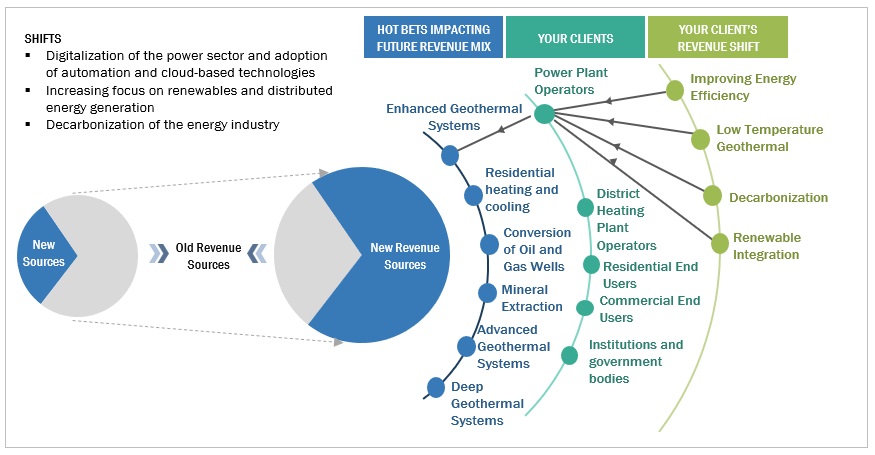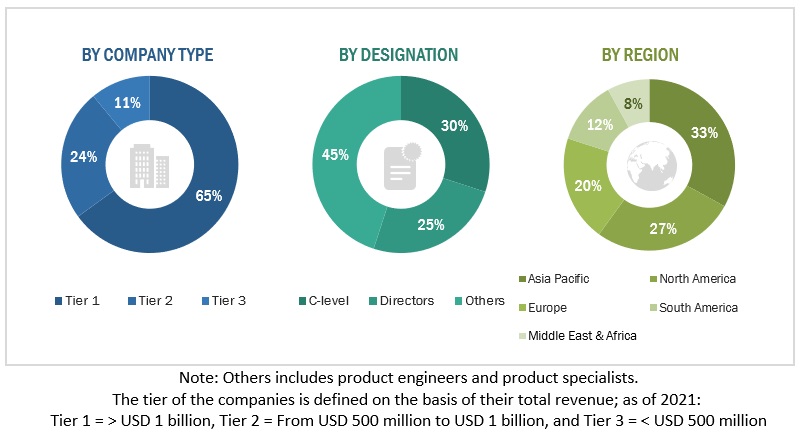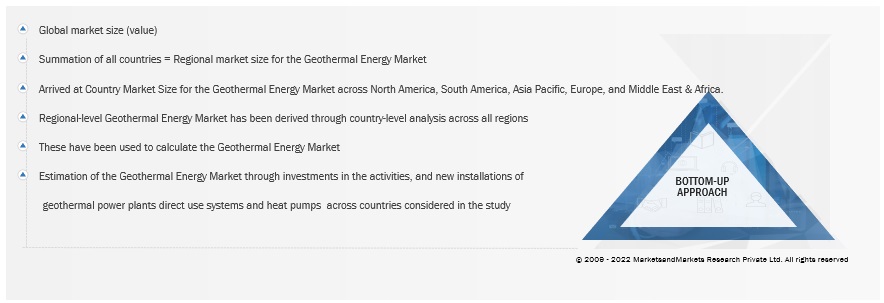Geothermal Energy Market by Application (Power Generation, Residential & Commercial Heating And Cooling), Temperature, Technology (Binary & Flash Cycle Plant, Dry Steam Plant, Ground Source Heat Pumps, Direct Systems) & Region - Global Forecast to 2027
[286 Pages Report] The global geothermal energy market size was valued at $6.6 Billion in 2021, and geothermal energy industry is projected to reach $9.4 billion by 2027, growing at a CAGR of 5.9% from 2022 to 2027. In recent times, the geothermal energy market has been experiencing fast growth due to the confluence of favorable factors: firstly, real growing demand for renewable sources of energy impelled by the dire need to reduce carbon emissions and counter climate change, and secondly, improved technology for drilling and enhanced geothermal systems that increased economic feasibility in the exploitation of geothermal resources even from locations considered non-viable. The market is also benefiting from an increase in awareness of the dependability of geothermal energy, and the fact that baseload power supply can be effectively and reliably delivered with it-something many other renewable sources, like solar and wind, are incapable of doing. Moreover, increasing demand for constant power supply among residential, commercial, and industrial sectors, and growing demand for electricity generation through sustainable means in industries are the major driving factor for the geothermal energy market.

To know about the assumptions considered for the study, Request for Free Sample Report
Geothermal Energy Market Dynamics
Driver: Rising demand for power generation through sustainable means
Conventional geothermal resources currently exploited technologies are dominated by the following in the generation of geothermal electricity: dry steam plants, single flash plants, double flash plants, triple flash plants, binary plants, and combined cycle or hybrid plants. As high-quality conventional resources become increasingly inaccessible, deeper resources may become accessible in the future through the development of enhanced geothermal systems.
Additional capacity was added in several countries apart from Colombia and Taiwan, which have added geothermal power newly in the year. The US is the leading producer of geothermal electricity in the world. In 2021, geothermal power plants in California, Nevada, Utah, Oregon, Hawaii, Idaho and New Mexico produced about 16.2 billion kilowatt-hours (kWh) equal to about 0.4% of total US utility-scale electricity generation. By 2050, geothermal power output in and outside of the western part of the US could be greatly increased to provide 60+ gigawatts electric (GWe) of reliable, flexible clean energy.
Restraint: Lack of exploration and drilling techniques
Well drilling, construction, and operation in these harsh geothermal environments require advanced techniques and technologies relative to the drilling of water or oil and gas. The process of drilling a geothermal well is plagued with lost circulation, nonproductive time due to trips, and inefficiencies brought about by low rates of penetration and damaging drilling dynamics. Enhancement of the efficiency of drilling and system performance is very slow, while upfront drilling cost keeps growing significantly. Because drilling operations comprise a major part of the cost of geothermal development, more efficient drilling can reduce risk and cost to help increase near-term geothermal development. Private companies are working to advance high-temperature/ hard-rock geothermal drilling technology. Currently, the average geothermal drilling rate of hard rock and crystalline formations is about 125 ft/day; this compares to larger and more economical wells drilled for the petroleum industry, which makes geothermal drilling relatively slow and costly. Unlike relatively short-lived oil and gas wells, geothermal wells are expected to have a multi-decadal life-span under continuous operation in aggressive conditions and therefore need well materials-casing and cement backing-capable of surviving for many years at temperatures over 300°C and in high saline fluid conditions >1M.
Similarly, collection of downhole data in the oil and gas industry has been reducing time for drilling and its cost while increasing the rate of penetration by 35%–55%. Geothermal drilling can be optimized through new technologies in sensing and electronics, which can reduce time by 50%. New downhole drilling and data collection tools need to be developed using new materials and designs that would provide enhanced temperature and pressure capability for these instruments in high-temperature geothermal wells (>250°C). Current downhole sensor technology has a reliability problem over 150°C, while the predicted drilling environments for geothermal applications exceed 400°C.
Opportunities: Geothermal potential for low- and medium-temperature resources
Geothermal energy from low-to-moderate temperatures is considered to be heat derived from the geothermal fluid in the ground at temperatures of 300°F (150°C) or less. These systems represent a large energy resource for the world, but are economically challenging for electric power generation. In addition to the challenges facing all geothermal development, including exploration, permitting, financing, and operation, the low-temperature resources have low exergy and corresponding efficiencies for converting the heat to electricity. This means that certain low-temperature resources may be used in binary cycle electricity generating technology. Most of the geothermal resources presently used are being applied to direct-use applications, including space heating, district heating, greenhouses, fisheries, mineral recovery, and industrial process heat. The low-temperature geothermal energy resources can be utilized by different community customers such as urban centers, rural areas, and remote communities. Very low-temperature geothermal energy can be recovered from heat sources under 30°C.
This geothermal energy can be utilized for heating applications via heat pumps. These applications include homes, apartments, and commercial buildings such as offices and malls. These days, urban planners are increasingly making use of very low-temperature geothermal resources for the heating and cooling of large complexes. Low-temperature resources have the potential to contribute largely toward the global geothermal industry portfolio. According to the US Geological Survey, there are about 120,000 megawatts of undeveloped low-temperature geothermal resources in the US. These generally occur in the eastern US states. In 2021, the US DoE announced ~USD 15 million for research and development to help grow US low-to-moderate temperature geothermal resources and coproduced resources. The government is striving for wide production of low-temperature power through advances in surface and down-hole technology, better education and outreach, and a greater collaboration between the government and industry. Very low-temperature geothermal energy has increasingly been applied globally by urban planners for heating and cooling large complexes. Low-temperature resources stand to have a high prospect of making fairly sufficient contributions to the geothermal global portfolio.
Challenges: Environmental disruptions have caused various challenges to the process of geothermal energy extraction
Funding and availability of regulatory agency staff to approve and process geothermal lease nominations could also extend timelines, particularly when there is a need for engagement with separate federal and state land management agencies. Geothermal development timelines also depend on the review and processing stages related to federal permitting. Staff experiences and processes vary between federal and state permitting offices. At the federal level, in areas with active geothermal projects, field office federal leasing and permitting staff may have experience with geothermal development, while those in other areas without projects may not have enough experience to process new applications. In areas with experienced staff, delays may also occur because geothermal experts cannot be made available due to competing priorities or other reasons. Data from each of these phases in the geothermal exploration and resource confirmation helps dictate whether and how to proceed with development. To date, each of these phases in the process of geothermal development may require sequential environmental reviews under existing processes. The length and number of environmental reviews required for one geothermal project have an impact on the deployment of geothermal resources.
More than 40% of the United States geothermal electricity capacity is located on leases issued by the Bureau of Land Management. Geothermal projects on federally managed land in the United States can be subjected to NEPA environmental review process at least six times from agency land-use planning through the construction of a power plant and associated transmission infrastructure. Various reviews and NEPA analyses make confirmation of the resource more costly and risky. The delay and the need for additional steps may result in a 5–7-year period—rather than a 1–3-year period—until a permit applicant has a bankable geothermal development. Legislation is in place at the federal level, Bund, as well as at state, Länder, level.
Geothermal energy in Germany is regulated by the Federal Mining Act Bundesberggesetz. The legal regulations of the geothermal operations in France are based upon two main decrees. Decree 77-620 of 16 June 1977 added a new title "Low temperature geothermal deposits" to the Mining Law (Code Minier) introducing an obligation to obtain an exploration permit before drilling and an exploitation permit before starting up production. Decree 74-498 of 24 March 1978 defined laws relative to "Geothermal prospecting and exploitation licenses". According to the said decrees, the geothermal resources are considered concessible and therefore assimilated into mines. All drillings deeper than 100m are ruled by the Mining Code and thus subject to a declaration to the competent authority, Direction Regionale de l'Industrie, de la Recherche et de l'Environnement (DRIRE), which is linked to the Ministry of Industry through Direction Générale de l'Energie et des Matières Premières (DGEMP). In Hungary, issues about geothermal development are covered under the following separate laws: Mining Law, no. XLVIII, 1993; Water Management Law, no. LVII, 1995; Concession Law, no. XI, 1991. In thermal water use, the components of water, production well(s), and land property are dealt with by different laws.
Market Trends

To know about the assumptions considered for the study, download the pdf brochure
Commercial Heating and Cooling segment, by application, is expected to grow at the highest CAGR during the forecast period
Application-wise, the geothermal market size is segmented into power-generation, residential heating and cooling, commercial heating and cooling, and others. In commercial, Geothermal Energy is mainly utilized for commercial applications like space and water heating. Due to the continuous adoption of geothermal energy in the office buildings to reduce electricity consumption. Many of the warehouses used geothermal energy to heat up asphalt to desired temperatures. Demand for energy by smaller business establishments for heating and cooling purposes supports the growth in the geothermal market for commercial heating and cooling.
By Temperature, the low temperature segment is expected to be the second-largest during the forecast period
The geothermal energy industry can be categorized into three broad groups according to temperature: low temperature, medium temperature, and high temperature. Generally, low-temperature geothermal resources are used directly for heating and recreation applications. Geothermal heat can almost be tapped anywhere in the world and used directly as a source of heat. This heat energy is mainly found in pockets of low-temperature zones that are normally found a few meters below ground. People have used these pockets of geothermal energy for cooking, comfort, and healing since time immemorial. Growth in the low temperature segment is attributed to easy availability through vents and geysers, and an increase in adaptation of geothermal heat pumps at home.
Asia Pacific is expected to be the largest geothermal energy market during the forecast period
The Asia-Pacific region is expected to be the largest in the geothermal energy market size in 2021 and is also the fastest-growing region. Most of the countries in the region of Asia-Pacific are now focusing on the geothermal energy to meet the ever-increasing demand of electricity and also to accomplish the net zero emission goal of CO2. Geothermal resources are aplenty in Indonesia, New Zealand, and other Asia-Pacific countries and can be gainfully employed as sources of climate-friendly energy in all weathers. Large investments are thus being made, both by the governments and private companies.

Key Market Players
The geothermal energy market is served by a mix of large international players with operational presence across the globe and local players commanding a strong supply network in the domestic market. The leading players in the global geothermal energy market include Ormat (US), Mitsubishi Heavy Industries (Japan), Baker Hughes Company (US), NIBE Group (Sweden), and SLB (US). Strategies such as product launches, contracts, agreements, partnerships, collaborations, alliances, acquisitions, and expansions are followed by these companies to increase their market share.
Geothermal Energy Market Report Scope
|
Report Coverage |
Details |
|
Market size: |
USD 7.0 billion in 2022 to USD 9.4 billion by 2027 |
|
Growth Rate: |
5.9% |
|
Largest Market: |
Asia Pacific |
|
Market Dynamics: |
Drivers, Restraints, Opportunities & Challenges |
|
Forecast Period: |
2022-2027 |
|
Forecast Units: |
Value (USD Billion) |
|
Report Coverage: |
Revenue Forecast, Competitive Landscape, Growth Factors, and Trends |
|
Segments Covered: |
Geothermal Energy Market by Technology, Temperature, Application, and Region |
|
Geographies Covered: |
Asia Pacific, North America, Europe, Latin America, and Middle East and Africa |
|
Report Highlights:
|
Updated financial information / product portfolio of players |
|
Key Market Opportunities: |
Emergence of advanced technologies and rise of Geothermal 2.0 |
|
Key Market Drivers: |
Rising demand for power generation through sustainable means |
This research report categorizes the geothermal power market by technology, temperature, application, and region
On the basis of technology, the geothermal energy market has been segmented as follows:
- Binary Cycle Plants
- Flash Steam Plants
- Dry Steam Plants
- Ground Source Heat Pumps
- Direct Systems
- Others
On the basis of temperature, the geothermal energy market has been segmented as follows:
- Low Temperature (Up to 900C)
- Medium Temperature (900C – 1500C)
- High Temperature (Above 1500C)
On the basis of application, the geothermal power market has been segmented as follows:
- Power Generation
- Residential Heating and Cooling
- Commercial Heating and Cooling
On the basis of region, the geothermal power market has been segmented as follows:
- Asia Pacific
- Europe
- North America
- Middle East & Africa
- South America
Recent Developments
- Ormat announced in July 2022 that the Casa Diablo-IV (CD4) 30 MW geothermal power plant had reached commercial operation. Under a 10-year PPA, the CD4 facility provides 7 MW of geothermal power to each of the Community Choice Aggregators, Silicon Valley Clean Energy, and Central Coast Community Energy. The facility also provides 16 MW of geothermal power to the Southern California Public Power Authority under a 25-year agreement.
- In March 2021, Ormat introduced a new high-performance between-bearings turbine. The company has employed the classical radially split casing design to support the turbine rotor between axially spaced bearings for its new product.
- In May 2021, Iberdrola and Mitsubishi Power, the energy solutions subsidiary of Mitsubishi Heavy Industries, agreed to a collaboration deal for the joint development of competitive, clean, safe energy solutions based on renewable energy. This would drive the decarbonization of industrial production in various parts of the world.
- In May 2022, Baker Hughes Company announced an investment in San Francisco-based GreenFire Energy Inc., a firm dealing with the development of closed-loop Advanced Geothermal Systems. The companies will accelerate the development of geothermal resources by retrofitting both existing non-producing geothermal and oil and gas wells to closed-loop heat-producing wells for power generation and direct-use applications. Additionally, Baker Hughes and GreenFire Energy will be involved in project feasibility analyses, the installation of systems, and the development of projects worldwide.
- SLB launched the GeoSphere 360 3D reservoir mapping-while-drilling service at IPTC last February 2022. This uses very advanced cloud and digital solutions to provide real-time 3D profiling of reservoir objects. It serves to enhance an understanding of the reservoir and then permits improved well placement with returns from complex reservoirs.
Frequently Asked Questions (FAQ):
What is the current size of the geothermal energy market?
The current market size of the geothermal energy market is 6.6 Billion in 2021.
What are the major drivers for the geothermal energy market?
Rising demand for power generation through sustainable means and the need for cost efficient cooling are some of the major driving factors for the geothermal energy market
Which is the fastest-growing region during the forecasted period in the geothermal energy market?
Asia Pacific is expected to dominate the geothermal energy market between 2022–2027, followed by Europe and North America. The favorable government policies and the need for cost efficient residential heating are the reasons for the region’s significant market size.
Which is the largest segment, by application during the forecasted period in the geothermal energy market?
The power generation segment is expected to be the largest segment by application during the forecast period
To speak to our analyst for a discussion on the above findings, click Speak to Analyst

The study involved major activities in estimating the current size of the geothermal energy market. Exhaustive secondary research was done to collect information on the peer and parent markets. The next step was to validate these findings, assumptions, and sizing with industry experts across the value chain through primary research. Both top-down and bottom-up approaches were employed to estimate the complete market size. Thereafter, market breakdown and data triangulation were used to estimate the market size of the segments and subsegments.
Secondary Research
This research study on the geothermal energy market involved the use of extensive secondary sources, directories, and databases, such as Hoovers, Bloomberg, Businessweek, IEA Geothermal, International Energy Agency, and BP Statistical Review of World Energy, to identify and collect information useful for a technical, market-oriented, and commercial study of the market. The other secondary sources included annual reports, press releases & investor presentations of companies, white papers, certified publications, articles by recognized authors, manufacturer associations, trade directories, and databases.
Primary Research
The market comprises several stakeholders such as power plant manufacturers, ground source heat pump manufacturers, manufacturing technology providers, and technical support providers in the supply chain. The demand side of this market is characterized by the rising demand for geothermal energy in, power generation, residential heat & cooling, commercial heat & cooling, and others applications. The supply side is characterized by rising demand for contracts from the industrial sector, and mergers & acquisitions among big players. Various primary sources from both the supply and demand sides of the market were interviewed to obtain qualitative and quantitative information. Following is the breakdown of primary respondents:

To know about the assumptions considered for the study, download the pdf brochure
Market Size Estimation
Both top-down and bottom-up approaches were used to estimate and validate the total size of the geothermal energy market. These methods were also used extensively to estimate the size of various subsegments in the market. The research methodology used to estimate the market size includes the following:
- The key players in the industry and market have been identified through extensive secondary research, and their market share in the respective regions have been determined through both primary and secondary research.
- The industry’s value chain and market size, in terms of value, have been determined through primary and secondary research processes.
- All percentage shares, splits, and breakdowns have been determined using secondary sources and verified through primary sources.
Geothermal Energy Market Size: Bottom-Up Approach

To know about the assumptions considered for the study, Request for Free Sample Report
Data Triangulation
After arriving at the overall market size from the estimation process explained above, the total market has been split into several segments. To complete the overall market engineering process and arrive at the exact statistics for all the segments and subsegments, the data triangulation and market breakdown processes have been employed, wherever applicable. The data has been triangulated by studying various factors and trends from both the demand- and supply sides. Along with this, the market has been validated using both the top-down and bottom-up approaches.
Objectives of the Study
- To define, describe, segment, and forecast the geothermal energy market on the basis of technology, temperature, application, and region
- To provide detailed information on the major factors influencing the growth of the market (drivers, restraints, opportunities, and challenges)
- To strategically analyze the market with respect to individual growth trends, future expansions, and the contribution of each segment to the market
- To analyze market opportunities for stakeholders and details of the competitive landscape for market leaders
- To forecast the growth of the market with respect to the main regions (Asia Pacific, Europe, North America, South America, and Middle East & Africa)
- To strategically profile key players and comprehensively analyze their market rankings and core competencies
- To track and analyze competitive developments in the market, such as contracts and agreements, investments and expansions, new product developments, and mergers and acquisitions
Available Customizations:
With the given market data, MarketsandMarkets offers customizations according to your specific needs. The following customization options are available for a report:
Product Analysis
- Product matrix, which provides a detailed comparison of the product portfolio of each company
Company Information
- Detailed analyses and profiling of additional market players



 Generating Response ...
Generating Response ...











Growth opportunities and latent adjacency in Geothermal Energy Market